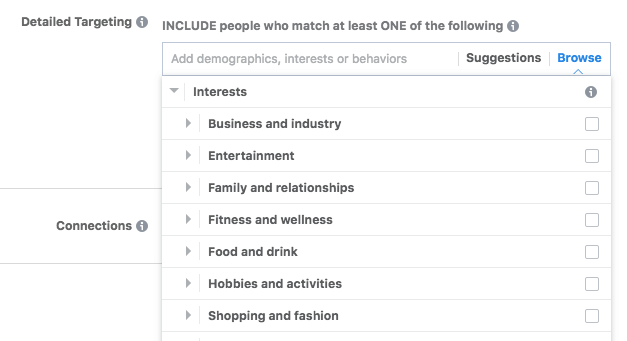Analysis check! It’s target marketing time. Do you know your customers? One of the most fundamental aspects of being good at sales is understanding your end customer. This means taking a deep dive into your customer avatar to coherently understand the finer aspects of their lives and shopping behaviours. This means customer targeting, and to understand this idea we will be using the sports equipment industry as our guinea pig.
Target marketing is not a new concept. Before the internet came along sellers relied on their instincts and business prowess to find new customers in whatever capacity was immediately available around them. For some, it meant driving their car around their local town and going door to door. For others, it meant making signs and posting them in city centres or cold calling strangers. Way back in time merchants travelled thousands of miles to seek new trading partners. Now with one simple click of a button, we can target customers globally! I mean, what a time to be alive eh?
Sometimes it’s easy to forget but we really do live in the best time in history for growing brands quickly. However, with so much competition and noise, it can be challenging to navigate. Technology may increase our ability to market easily, but not every business hit that mark during this particularly important part of the process. Finding the perfect customers can be a bit like finding a needle in a haystack. Having stellar technology does not always equal stellar sales. There is still human error involved with customer targeting. Sometimes we rely too much on technology to do all the work for us without doing our due diligence first! This means knowing everything about our customers. Where do they shop? What type of tv shows are they interested in? What other products do they like?
Table of Contents
ToggleThough technology is changing and challenging, consumer behaviours and habits rarely change over time. Whether it’s a loaf of bread or the newest fitness equipment, if someone wants it, they will buy it. At the most basic level of what eCommerce does is “fill a need,” right? When someone is hungry, they eat. When someone is thirsty, they drink. When someone wants the latest and coolest fitness gear, they get it online. However, now it gets a bit more technical. We must learn the best ways to “aggregate eyeballs.” So, it’s time to get back to basics.
WHAT IS TARGET MARKETING?
The target marketing definition is focused marketing on your ideal customer demographic with the goal to drive sales and accrue repeat customers. It is very specific and includes many different elements. Now, not every sale that comes through your store means that the customer is the same as your average daily buyer, but you still need to know your market. This is how you build a community around your products and accrue repeat sales – building a legacy brand.
Many businesses may claim to know what online customer targeting means on a surface level, I.e., Age and gender. However, age and gender are still extremely broad. For example, simply just targeting males and females between 25-40 in the United Kingdom will give you a customer target size of 18 million, six-hundred thousand people. Though that seems good (high number of potential customers), it is not specific enough. Whereas many brands focus on the whole pie, some of the most successful brands focus on one little slice, which when extrapolated is still worth hundreds of millions.
A study by Adweek concluded “about 76% of marketers fail to use behavioural data to target customers online with relevant advertisements.”
This is why so much money is left on the table with marketers failing to reach their relevant demographic.
WHY IS CUSTOMER TARGETING IMPORTANT IN YOUR INDUSTRY?
Customer targeting matters for sales, longevity, and growth. Spending money to gain customers who are not interested in what you have to offer is the same as throwing your money away. To put it in simpler terms, if you are fishing for salmon in a lake filled with trout you are wasting your time. You will not get the results you want no matter how much fishing you do.
Target marketing is important, especially in 2021, for two big reasons.
1) COMPETITION
There are so many brands and options. The customer is more in control today with a vast array of options including shipping, quality, and pricing. From third-party sellers to brick & mortar stores, sports equipment is everywhere.
2) GROWTH POTENTIAL
Random and inconsistent sales due to failed targeting mean low growth potential for your business. Tapping into a sea of ideal customers equates to higher chances for sales and growth. Focusing on lower-performing pieces of sports equipment such as underperforming market items may be better products to sell. For example, table tennis bats vs the saturated cricket gear market. When sights are set too high and too broad, brands end up getting into big arenas with far too many large players.
Creative ways to compete successfully with other brands include more niche products, better pricing, and marketing to specific customer segments that are overlooked or undervalued.
For example, the UK sports equipment industry in 2020 reached revenues of £5 billion. If your business was only targeting 1% of that market segment, that equates to a £50 million pound market. That still sounds pretty good to me. Make sense?
This is why many niche markets do so well. For example:
Babiators is a lifestyle brand that specifically targets the kid sunglass market. They cleverly branded the world-famous brand “aviators” with the word baby and developed an undervalued market. This Shopify store does over £1 million a year in sales.
What about those brands that just focus on marketing to Gen Z? For example:
Gymshark started in Birmingham and is the UK’s most successful online sportswear brand valued at over £1billion. The CEO Ben Francis spotted a gap in the sportswear market which was the lack of affordable activewear for young gym-goers. They owe their success to keeping their focus on this niche market for people aged 16-30, along with a strong social media presence.

It’s about focusing on the ideal customers who shop in your category to meet their specialized and specific needs. Gymshark knew that most exercise apparel were marketed mostly to the above 30 plus crowd with gym memberships. This is a valuable lesson where certain needs are not being met. That’s a market in itself. Identifying neglected markets can be just as lucrative as identifying your ideal market.
The UK sports equipment market in 2020 proved a compound annual growth rate of 3% between 2016 and 2020. Save your business time and money by carrying out entry-level research by identifying the size, growth, major segments, and leading players in the industry.
WHAT TYPES OF TARGET MARKETING ARE THERE?
There are four main marketing segments to focus on which can be broken down into smaller segments.
1) Geographic – Where are they located?
2) Demographic – Age and Sex
3) Behavioural – The process involves web searches, purchase histories, and frequently visited websites & other mediums (podcasts, tv, apps).
4) Psychographic – Attitudes, interests, and values
Find ways to capture this specific information and deeply study your customer profile(s). This is the difference between broad targeting and laser-guided precision targeting.
WHAT IS AN EXAMPLE OF TARGETING MY IDEAL CUSTOMER?
After you start analysing your customer targeting with data look at research studies and polls. You can even create your own targeted surveys and use your own focus groups.
Online sporting equipment studies have found that 78% of adults over 18 exercises or would like to. Meanwhile, 27% of the adult population occasionally attends fitness facilities. This is important because it means that fitness is technically the world’s most prominent “sporting activity.”
A well-rounded list to identify your target market should include many distinct factors. In the sports equipment industry sector, a more targeted list would look something like this:


1) Age
2) Gender
3) Income level
4) Education Background
5) Lifestyle
6) Relationship status
7) Geographic location
8) Forms of entertainment & interests
9) Favourite sports and teams
10) Purchasing habits
Do you know how to define your own customer targeting based on this list?
TARGETING EXAMPLE:
To give a fictional example – A particular community in England has a great athletic history. It is located near a big university, home to lots of hiking and running trails. There are 10 youth centres within this segment that encourage kids’ sports. Because of this, my company will focus on this area and other areas like this including:
• Parents with children active in youth sports
• Active adults who enjoy sports and running
TARGET MARKETING
SPECIFIC MARKET SEGMENTATION:
• Parents with kids age 35 – 50 (Primary & Secondary school)
• Kids sports equipment aged 6 – 17
• Middle-aged adults out of college (25 – 34)
In this area, the two biggest sports are Rugby and Tennis. Knowing this information you can position your products within this location-specific demographic, encouraging these potential customers to shop with you.
The average household income in the area is £65,00 and the local council invests deeply in public parks, spaces, and activities. There are various sports leagues in need of kids sports equipment and parents take a hands-on approach to coach their children’s teams. The real estate market has grown by 5% over the last decade as more affluent middle-aged families are flocking to this specific area. Knowing the targeted research and insights such as these factors provides that extra layer of future-proofing repeat sales.
By focusing intensely on a target market, you can establish yourself as an industry expert on the wants and needs of your particular group. You can form your own plan around their interests and opinions while keeping a particularly close eye on the competition.
• This was a small fictional example. Make sure to do your own market research and collect data for similar conclusions along with a strategic competitor analysis.
CUSTOMER TARGETING WITH FACEBOOK
If you’re targeting consumers online, Facebook is one of the most popular sales channels to do this on. Reasons, why it’s so popular as well as daunting, is because of the copious amounts of specific targeting metrics. Some people can get easily overwhelmed with all the options. But that is not going to be you, is it? See examples below.


As you can see above, it is broken down from large categories into smaller categories from business and industry to hobbies and activities. The more you know about your customer characteristics the better. I would suggest taking trial runs on the Facebook Ad Manager to start getting creative ideas for customer targeting. You do not have to pay anything to discover targeting metrics.
LASTLY, DON’T FORGET TO OFFER GOOD OPTIONS FOR YOUR TARGET CUSTOMERS
So, you have great products. You’ve identified your target market. You get customers to your website – now don’t screw it up! If you don’t make the whole process convenient when shipping your products, you may not have returning customers. I am talking about checkout and final mile delivery.
1) FREE SHIPPING
No one wants to pay for shipping. Free shipping feels like a bargain to consumers. 90% of people view free shipping as the top incentive that encourages them to shop online more often. Essentially, not offering free shipping is the number one reason target customers abandon carts online. Therefore, offer it.
2) SAME DAY DISPATCH
Customer targeting won’t do you much good if your custom retention is low due to unhappy shipping times. Work with a 3pl that does same day dispatch. Offering next day delivery will keep you ahead of the competition.
CONCLUSION
I hope you have seen the value of customer targeting. It is the single most important step to take when starting your business and executing a sales strategy. The next step for you to do now is to identify your target market and create a customer profile. When you do this and start marketing accurately and consistently you will see the sales grow. Thank you so much for reading and if you have any questions about how Selazar can help you streamline your operations for your target customers, let us know.
